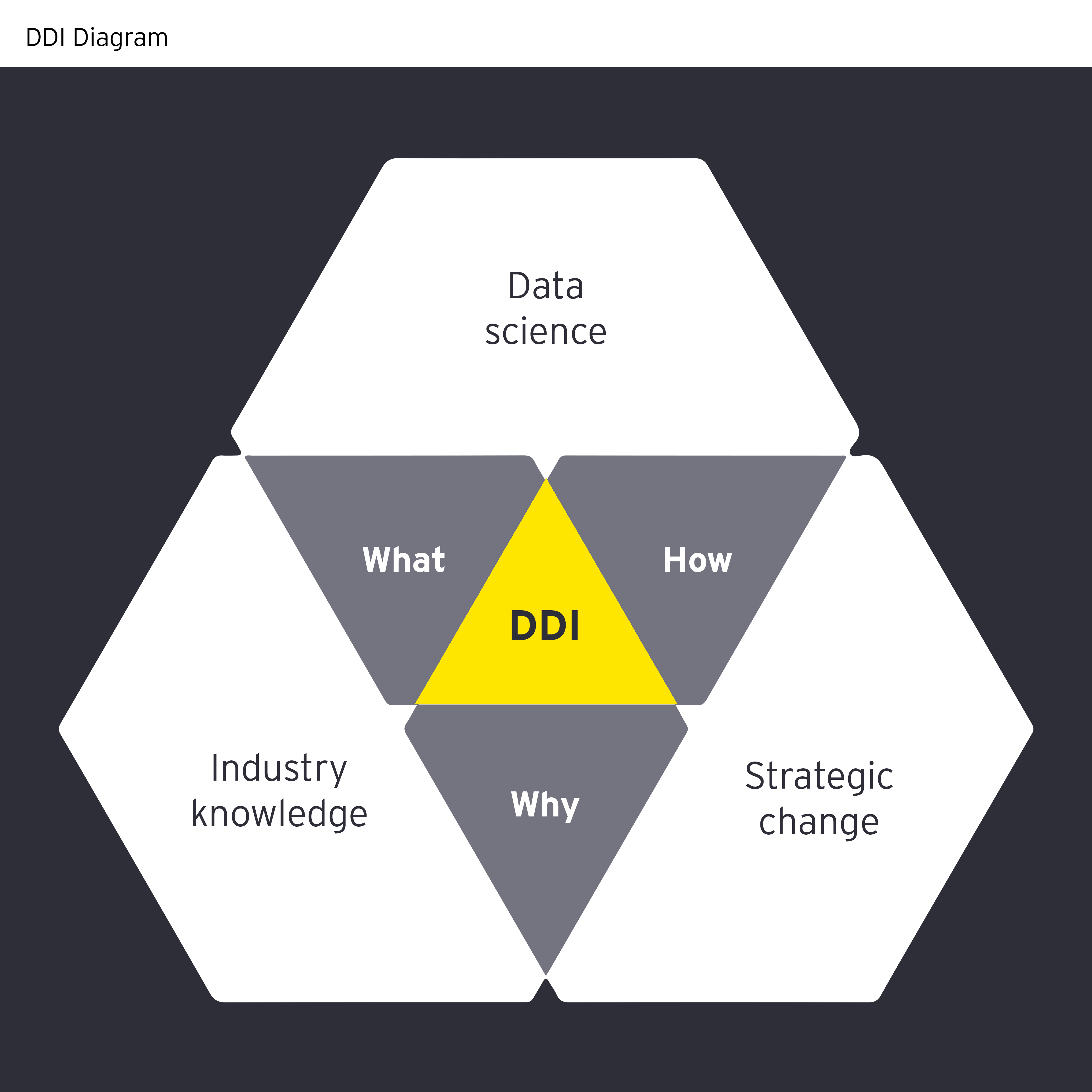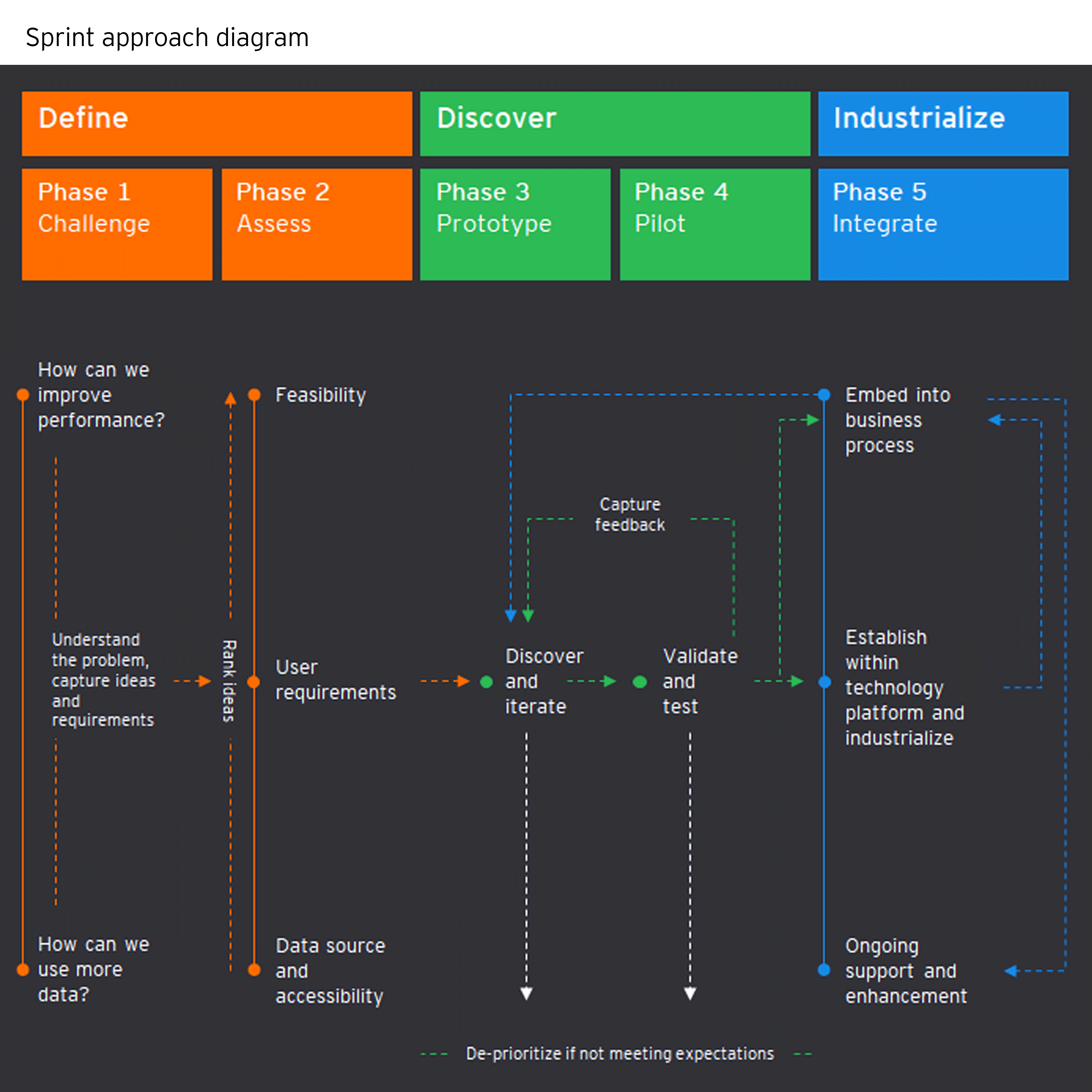
Chapter 1
Assemble the right team, ask the right questions to get the right results.
The rule of three for data-driven innovation teams
Data-driven innovation transcends industry and organization; it can be used successfully no matter the environment as long as there is appetite for change, alignment to strategy and expertise across data, technology and industry.
Where three critical elements intersect is where data-driven innovation finds success:

1. Strategic change – to innovate is to change; understanding how the right answers can be embedded into daily business life
2. Analytics – know the technology and techniques that will allow the data to find the right answers
3. Deep industry knowledge – knowing what the right questions to ask are for the specific industry and organization
Using this structure, EY teams have successfully applied data-driven innovation in industries as diverse as financial services, mining & metals, healthcare, retail and the public sector.
Developing a lean, purpose-built team across all three areas will enable organizations to ask the right questions that will then lead to the right changes, for real business value.
One particular healthcare client, was on a mission to turn data into an enterprise-wide asset for fact-based decision making and innovation. They were struggling in a number of areas including: the inability to track and report on research and operations data; no data creation control with zero governance; siloed data repositories; and manual, limited analysis capabilities.
After an initial review and strategy development cycle, EY data and analytics teams collaborated with the client’s people to implement a strategy that included a centralized, big data platform that helped enable real-time insights across the entire organization.
The ‘right questions’ were developed. For instance, around referrer analytics. “Why are they referring or not referring?” “Why is their referral mix the way it is? Who are the referrers and non-referrers? What is the quality and value of referrers?
Using the analytics solution developed with the EY teams, the client could track different referrers across the entire referral journey and make fact-based decisions to drive revenue growth such as acquiring new patients and referrers, as well as increase effectiveness and productivity.
Success for this client came from the blended team of SMEs, industry, strategy and technology.

Chapter 2
Set your people up to embrace and drive change.
Why people, speed and scale are vital
If you think of transformation as an arrow, the tip of the spear is data but what makes up the rest of that arrow is critical too. People, and understanding what needs to change to make data-driven decisions, is a fundamental building block of organizations, and will be where innovation succeeds or fails.
We developed an AI model for one client that predicts when part of their transportation network would fail to help optimize maintenance schedules. Key to this program’s success was engaging with the maintenance people themselves to explain how the AI model worked and get them bought into the approach. It was a completely new way of working for them; they went from doing what was quickest or closest, to doing what was most business critical. So far, the new approach is saving the client millions in recovered downtime.
Having the right team in place is fundamental to asking and answering the right questions. Next is being able to take the right answers and embed them in organizational decision making.
This has to be fast and at a scale that responds to the needs of the organization.
Quickly surfacing high value opportunities that align to the corporate strategy and then getting them out to the front line is what turns data-driven innovation into value.
The types of innovations EY teams have developed with data vary greatly. Some examples include closing customer profitability gaps, integrated value chain reporting, real-time price optimization beyond simple market responses, determining profitability drivers for specific business lines, customer loyalty directional growth, and demand forecasting.

Chapter 3
Deliver results and insights fast and have a clear plan for industrialization.
Sprints deliver rapid insights
Once the right team is in place, the right questions have been defined, there is buy-in from leadership and alignment to the corporate strategy, it is time to deliver insights. The on-shore / off-shore concept plays a role here – ‘industrializing’ the right answers can be done quickly at scale by others outside the innovation team.
The approach must be able to deliver value fast – think week two, not month six – and then prototype that ‘right answer’ so that the business benefit is felt almost immediately. This builds confidence from the business in the approach and opens the floodgates of ‘right questions’.
An agile ‘Analytics’ sprint approach, encourages and drives engagement from key stakeholders and means insights are delivered quickly and regularly. Under three broad areas there are five phases to the agile approach which help focus the team on one defined problem.

This approach breaks down the questions into bite sized pieces, making it less overwhelming and more output driven. The sprint also focuses decision makers on key performance drivers, floating the most important and achievable ‘questions’ to the top. Even when a sprint fails to produce results, it does so rapidly so time and money is never wasted. It’s a ‘fail fast’ approach.
One client had some specific concerns and wanted to look at pockets of the business where change could have the most impact. After engaging all the key senior stakeholders, EY teams knew what was keeping them awake at night. How do we simplify our supply chain? How do we optimize our business process? How can we change customer behavior to buying more than one item? How do we increase our share of foot traffic into stores?
It was then a matter of using data to prove, or indeed disprove, a number of hypotheses.
Summary
Most organizations have the desire to innovate with data and technology, but struggle to do so sustainably. This article advises on three must-dos to ensure successful data-drive innovation and strategic change.


